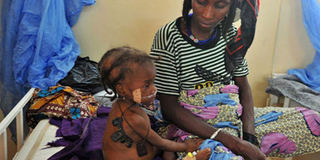More needs to be done to fight malnutrition

A three-year-old girl suffering from severe malnutrition sits with her pregnant mother awaiting a doctor's review in a medical tent at the Mirriah refugee camp, in the Zinder region of Niger. Investing in nutrition must be prioritised to save millions of children who cannot reach their full potential due to malnutrition. PHOTO | AFP
What you need to know:
- Kenya is the only country in East Africa that is on track to achieve the global nutrition targets established by the World Health Assembly.
- Investing in nutrition must be prioritised to save millions of children who cannot reach their full potential due to malnutrition.
- Stakeholders should work closely with research organisations to gather data and identify the gaps, and fill them in a more efficient way.
The Global Nutrition Report 2015 made it clear that global progress to reduce malnutrition is slow and uneven.
Nearly half of all 193 countries in the report face multiple serious burdens of malnutrition such as poor child growth, micronutrient deficiency, and adult overweight and obesity.
According to the report, Kenya is the only country in East Africa that is on track to achieve the global nutrition targets established by the World Health Assembly (WHA).
Kenya’s success is attributed to a combination of government commitment, effective nutrition programmes, and general poverty reduction.
We should celebrate this success.
However, we should never forget that malnutrition is a serious public health problem that needs to be eradicated.
The Global Nutrition Report proposes a number of steps that countries can take to eradicate malnutrition.
First, a conducive political environment for nutrition-improving actions is mandatory.
Actions to combat malnutrition require greater political commitment and goodwill to yield positive results.
The Kenyan government must provide the environment by taking the lead in formulation and implementation of these actions.
The Nutrition for Growth Summit in Rio de Janeiro provides an opportunity to report on progress and also for Kenya to set new targets.
Kenya must make commitments at this summit to accelerate progress towards eliminating malnutrition by 2030.
A NATIONAL EFFORT
Second, malnutrition-reducing actions require resources to implement.
Even though Kenya is on the right track in achieving the WHA targets, it has not invested enough in nutrition.
Investing in nutrition must be prioritised to save millions of children who cannot reach their full potential due to malnutrition.
Third, addressing malnutrition should take a multisectoral approach.
Issues of nutrition should not be left to the Ministry of Health alone to address because nutrition affects all sectors of the economy.
Every sector must be involved as family units are central points in eradicating malnutrition.
The government has to work with businesses, the private sector, individuals, donors, research organisations, and non-governmental organisations to ensure policy coherence and harmony in nutrition-related issues.
This calls for formulation and implementation of relevant policies.
For example, agriculture should start focusing on the nutrition value of food, not just quantities, and address variety.
School feeding programmes, where they exist, should use the services of both education and nutrition experts.
EXTERMINATING MALNUTRITION
Last, there is a need to identify data gaps and fill them.
Data-driven decisions have proven to be effective in addressing development issues.
This should also apply to addressing malnutrition.
With data, it will be possible to prioritise and to be more accountable.
Data will help in identifying the gaps and providing suggestions on how to fill them.
Stakeholders should work closely with research organisations to gather data and identify the gaps, and fill them in a more efficient way.
Malnutrition indeed can be eradicated. With a multisectoral approach, increased investment, enhanced accountability, and evidence-based policies and programming, malnutrition can be a thing of the past.




